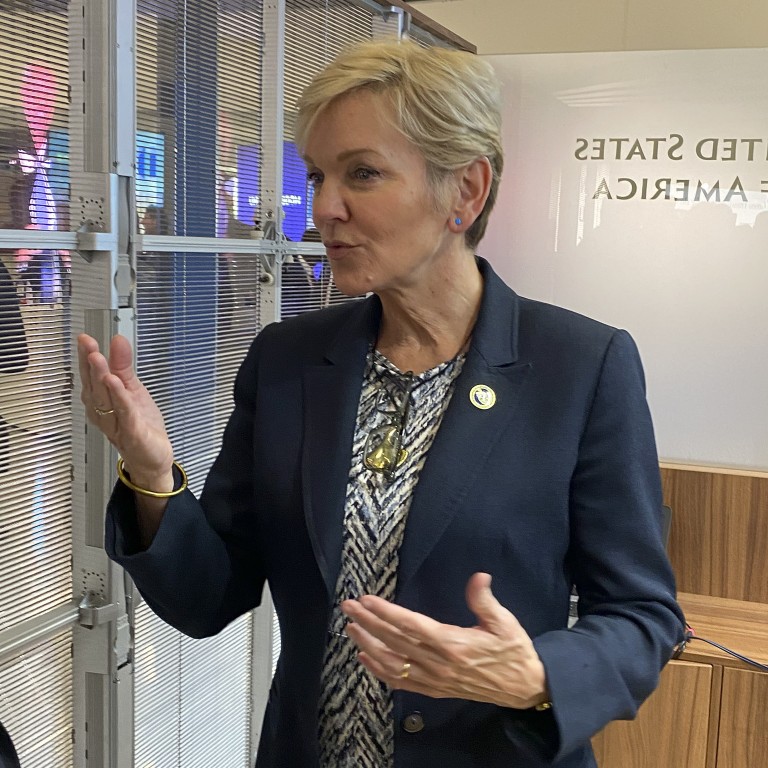
US aims to create nuclear fusion facility within 10 years, energy chief says
- ‘It’s not out of the realm of possibility’ that the US could achieve Joe Biden’s ‘decadal vision of commercial fusion,’ said Jennifer Granholm
- Fusion works by pressing hydrogen atoms into each other with such force that they combine into helium, releasing vast amounts of energy and heat
US energy secretary Jennifer Granholm said on Monday that nuclear fusion is a pioneering technology and the Biden administration wants to harness it as part of the transition to clean energy.
As part of its energy agenda, the Biden administration wants to create a commercial nuclear fusion facility within 10 years, Granholm said in a wide-ranging interview with Associated Press in Vienna.
Fusion works by pressing hydrogen atoms into each other with such force that they combine into helium, releasing enormous amounts of energy and heat. Unlike other nuclear reactions, it does not create radioactive waste. Proponents of nuclear fusion hope it could one day displace fossil fuels and other traditional energy sources. But producing carbon-free energy that powers homes and businesses from fusion is still decades away.
“It’s not out of the realm of possibility” that the US could achieve Biden’s “decadal vision of commercial fusion,” Granholm said.

A successful nuclear fusion was first achieved by researchers at the Lawrence Livermore National Laboratory in California last December in a breakthrough after decades of work.
Granholm also praised the role of the Vienna-based UN nuclear watchdog in verifying that states live up to their international commitments and do not use their nuclear programmes for illicit purposes, including to build nuclear weapons.
“The IAEA is instrumental in making sure that nuclear is harnessed for good and that it does not fall into the hands of bad actors,” she said.
The watchdog organisation has agreements with more than 170 states to inspect their nuclear programmes. The aim is to verify their nuclear activities and nuclear material and to confirm that it is used for peaceful purposes, including to generate energy.
Nuclear energy is also an essential component of the Biden administration’s goal of achieving a carbon pollution-free power sector by 2035 and net zero emissions economy by 2050.
Fusion power is a great hope but it won’t help with global warming now
Asked about the difficulty of finding storage sites for radioactive waste, Granholm said that the US has initiated a process to identify communities across the country who may be willing to host an interim storage location. Currently, most of the spent nuclear fuel is stored at various nuclear reactors across the country.
“We have identified 12 organisations that are going to be in discussion with communities across the country about whether they are interested (in hosting an interim site),” she said.
The US currently does not recycle spent nuclear fuel but other countries, including France, already have experience with it.
Spent nuclear fuel can be recycled in such a way that new fuel is created. But critics of the process say that it is not cost-effective and that it could lead to the proliferation of atomic weapons.
There are two proliferation concerns associated with recycling, according to the Washington-based Arms Control Association: The recycling process increases the risk that plutonium could be stolen by terrorists, and second, those countries with separated plutonium could produce nuclear weapons themselves.
“It has to be done very carefully with all these non-proliferation safeguards in place,” Granholm said.
Nuclear energy is still ‘on the cards’ for Asian countries despite Fukushima row
Granholm said that depending on whether the US government shuts down or not, the Biden administration could announce in October details on an $8 billion hydrogen hub programme that will be funded by the bipartisan infrastructure law.
A hub is meant to be a network of companies that produce clean hydrogen and of the industries that use it – heavy transport, for example – and infrastructure such as pipelines and refuelling stations. States and companies have teamed up to create hub proposals.
Environmental groups say hydrogen presents its own pollution and climate risks. When released into the atmosphere, it boosts volumes of methane and other greenhouse gases.
“Our goal is to get the cost of clean hydrogen down to 1 dollar per kilogram within one decade,” Granholm insisted.

As fossil fuel emissions continue warming Earth’s atmosphere and extreme weather phenomena occur globally, Granholm was asked her opinion on the announcement by Britain’s Prime Minister Rishi Sunak that the UK will delay crucial climate targets.
Sunak said last week that he will push back the deadline for selling new petrol and diesel cars and the phasing out of gas boilers as part of one of his biggest policy changes since taking office.
“When you see the heatwaves that the UK experienced this summer, I think it becomes obvious that we need to put on the accelerator,” she said, while adding that the UK has been a “great partner” in pushing modern technologies.
“We want to see everybody moving forward as quickly as possible (on the clean energy transition), including ourselves,” she said.

